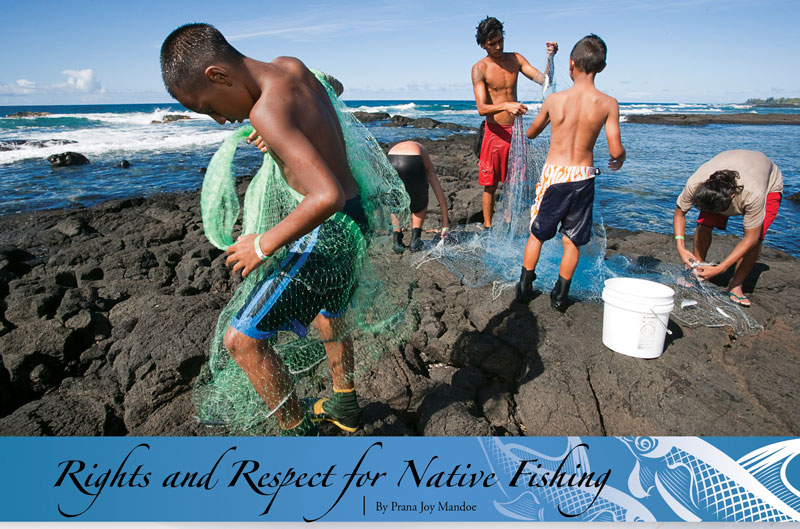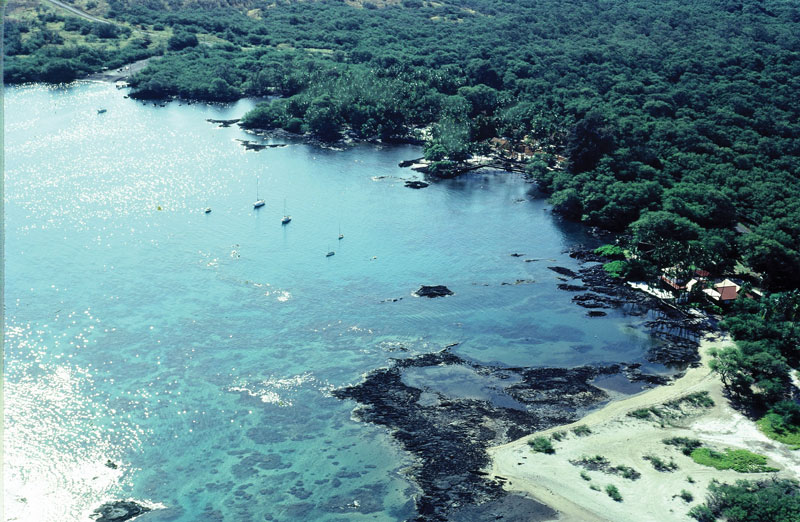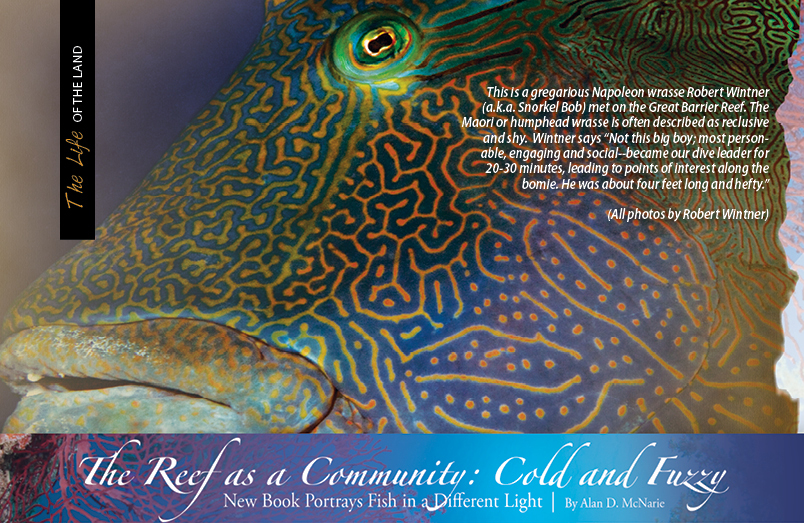
Rights and Respect for Native Fishing

By Prana Joy Mandoe
A few years ago, a Hawaiian fisherman noticed a huge ball of akule boiling off the pier at Kailua-Kona. He tucked his whip net under a boogie board and circled the fish. It was a grand catch! However, he knew he had to be smooth bringing it up, because Kailua Pier is in Zone A of the Kailua Bay Fisheries Management Area, where no net fishing is allowed. Just as he prepared to pull in the fish, a big tour boat drove in and parked over the net. The fisherman waited. Hours later, the boat pulled out and he hauled the net in. It was full of fish-heads. The puhi, or eels, had chomped every fish. What a waste! What disrespect! The tour boat operators didn’t even know they ruined the catch. Did the lawmakers realize that, in protecting marine life, they also criminalized our fisher’s natural and native act?
This disrespect can be a result of ignorance. The general public may not know how to be respectful of fishermen or of Native Hawaiian rights. Fishing people, on the other hand, may not appreciate modern conservation laws. It is imperative that we conserve marine life and ocean habitats; Native Hawaiian fishing practices must be respected in the process. Additionally, it is important to support people of all races who wish to eat from the ocean.
In times gone by, respect for fishermen was a given. “The professions of fishing and farming were the important, honored professions of our people,” wrote Daniel Kaha’ulelio in 1902. Skilled fishermen and farmers were sought after for marriage, because they were like Social Security: they would feed you in old age. Conservation was built into the kapu, or system of religious law. For example, ‘opelu were caught and eaten from roughly July to January, at which time aku was not touched under penalty of death. From January to July, aku were open, and ‘opelu were forbidden.
The kapu system was overthrown in 1819, and the islands were caught in the net of cultural change. Much has shifted: fishing techniques, laws, environment and attitudes. Nowadays, tourist and other recreational uses of the ocean outweigh respect for native fishing. Even regulations meant to conserve the ocean hurt fishermen. Sometimes the need for conservation is forgotten in the heat of anger or the push for survival. Fishing has become a business and sport as well as a subsistence lifestyle.
So how does one respect native fishermen in today’s world?
“Don’t chase the fish away,” says Oli Turalde, age 22. That’s Rule of Respect No. 1.
For a beachgoer, this means if somebody is pole fishing, throwing net, or spear diving, don’t swim or paddle out near them. If they’re fishing off boats, keep your distance.
“You see someone diving out there with their boat anchored,” explains Oli’s father, Keoni Turalde, a subsistence fisherman and former commercial diver. “People go by with their boats or jet skis… making big noise. That’s not respect.” He recommends giving fishermen the whole bay, or at least more than 150 feet.
That’s easy, but it’s just a start. What else shows respect?
Big ticket issues that chase fish away include pollution and destruction of reefs. Conservation efforts aimed at reversing these trends often outlaw native fishing practices that are hurt by this same pollution and destruction. So, if you are in a position to make decisions affecting the long-term health of ocean habitats, please consider the marine environment, the fish, fishermen, and our local diet. Factors like chemicals used on golf courses, agricultural run-off, sewage systems, non-point pollution and blasting the coast to create false lagoons affect whole ecosystems. Naturally, these factors affect fish habitat, which is fundamental to fishermen.
And this leads us to Rule of Respect No. 2: Don’t chase the fishermen away.
Unfortunately, fishermen get pushed out all the time. Native Hawaiian fishermen get fenced off their traditional fishing trails, blocked by massive developments, even criminalized for the food they catch. The right to fish and eat turns out to be a hotly contested cultural conflict; it involves 150 years of constitutional law. Hawaiian rights to gather on undeveloped lands—including the ocean—were expressly preserved when the private property model of land tenure was implemented in 1848, and they have been upheld in court to this day. (A recent decision was Public Access Shoreline Hawai’i v. Hawai’i Planning Commission in 1995.) Article XII, section 7 of the Hawai’i Constitution (1978) says:
The State reaffirms and shall protect all rights, customarily and traditionally exercised for subsistence, cultural and religious purposes and possessed by ahupua’a tenants who are descendants of native Hawaiians who inhabited the Hawaiian Islands prior to 1778, subject to the right of the State to regulate such rights.
Landowners, take notice! The western concept of exclusivity, or the ability to keep people off one’s land, does not apply universally in Hawai’i. Cultural practitioners can enter private lands to do traditional practices. Specifically regarding fishing, native Hawaiians have the legal right to access the coast, and generally the humility to do so in a respectful way.
As Oli Turalde puts it, “We get rights to beach access. We can be five feet away from the highest waterline. If they [landowners] build one wall, we can go on ‘em.”
So don’t fence off fishing trails. It hurts, says the elder Turalde, when people suddenly cannot go where they have been fishing all their lives. Furthermore, native fishermen request, if you buy shoreline property, don’t imagine you own the beach. (Beaches are public property.) Don’t build back-to-back developments that change the nature and culture of a place. If you undertake a conservation project, do so supporting native fishing practice. If not, we may convert subsistence areas to tourist attractions, lose knowledge of feeding ourselves, and suffer more social ills. Problems develop when people are cut off from their ancestral work.
A fisherman I’ll call Lawai’a, since he asked me not to print his name, throws net and sells fish door-to-door for a living. He shares how expanding developments make him feel.
“[Some resorts] so big, for just get to the ocean, might as well go somewhere else,” he says. “[At] the guard shack, the guards tell us the public parking is full, and we go inside, no-one stay there…. [The residents] asking me where I live. I tell them, ‘Where they from? ’ They say they are residents, and I say, ‘So am I…’”
“As one people trying to survive, we are smothered,” he continues. “Swarmed… They come over here and make us feel like foreigners… Make you feel shame for what I do in my life. They make you feel like you taking too much, just for live.”
Both Lawai’a and Turalde were raised in long-time Hawaiian fishing families, and both have had run-ins with the law. For Turalde, it was over turtle. As a boy, turtle was his family’s meat. In the 1960s, however, turtle steak and ornaments became a craze, and the honu population plummeted. In 1978, the green sea turtle was listed on the Endangered Species List. Turalde was once charged for catching turtle, just for home consumption, but the charges were dropped when he asserted native gathering rights. Now he reminisces.
“As a kanaka maoli [native Hawaiian], I been eating turtle since I was a baby. Raised up in my grandma and grandpa’s lifestyle—they had 20 kids—and eat what they feed me, and learn what they been taught by their parents for the same kind of living…. Hopefully the state would let the kanaka maoli catch turtle and eat turtle again.”
Here we see a native food banned because of over-harvesting for the retail industry; the conservation law that followed both enabled the honu population to come back and shut down a traditional Hawaiian practice.
For our second fisherman, Lawai’a, the run-in with the law had to do with location. A game warden saw him walk through Wai’opae Tide Pools, a conservation zone, with a throw net. His wife says that, although court transcripts affirm the warden never saw him throw net, and although he was just carrying his net to a legal fishing ground (which is not against the law), her husband may face jail time.
“Can I come back tomorrow and fish where I once was from?” asks Lawai’a. “Is this my heritage?”
Many people respect fishermen like Turalde and our anonymous informants; we love to eat fish, and fishermen are generous folks. Nevertheless, today’s cultural landscape threatens their lifestyle. Turalde suggests that when new people come to the islands, they should get to know native people and the local lifestyle better.
“We [are] just the poor surviving in this high cost of living, in this American way of interaction,” he explains.
So show some respect. Take care of fish and their habitat. Welcome native fishermen. This is, after all, their home. We can appreciate the many time-tested ways in which they know how to make a sustainable living. Listening to them, we can learn how best to nurture our natural island home.
Works Cited:
Kaha’ulelio, Daniel. Ka ‘Oihana Lawai’a: Hawaiian Fishing Traditions. Mary Kawena Puku’i, trans. Bishop Museum Press, Honolulu: 2006.
Malo, David. Hawaiian Antiquities. Dr. N. B. Emerson, trans. Honolulu, 1898. Hawaiian Gazette Company, Ltd.: 1903.
Public Access Shoreline Hawai‘i
Richardson, W. Knox. “The Art and Science of the Green Sea Turtle: Early ‘Life Force’ Icon Thrives as ‘Modern Kapu.’ ” Oahu Island News. December 2004.
“The Green Sea Turtle.” The Hawaii Association for Marine Education and Research, Inc.
“Regulated Fishing Areas on Hawai‘i Island.” Division of Aquatic Resources. State of Hawai’i: 2008-2010.
“Marine Life Conservation District” Division of Aquatic Resources. State of Hawai‘i: 2008-2010.


